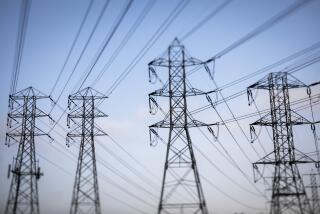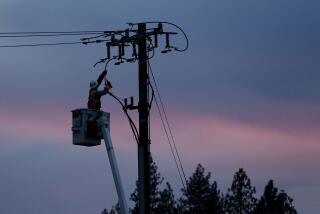Utility Tax Cut of 1% May Be Step Toward Abolishing It : Finances: Slightly improved economic outlook and belt-tightening at City Hall allow council to keep its pledge, however small the payoff.
- Share via
NORWALK — Norwalk gave its residents an unlikely gift this week: lower taxes.
The City Council took the unusual step of cutting a utility users tax imposed last year from 8% to 7%. That means a savings of about $1 a month for the average household on every $100 of telephone, gas and electricity bills when the reduction takes effect in October.
While the cut is not much, it bucks the trend among Southeast cities toward higher taxes to pay for services. Downey, Artesia, Paramount and Whittier are among area cities that imposed new taxes or increased existing fees this year to help balance their budgets.
Norwalk Mayor Luigi A. Vernola said the unanimous decision to cut the tax is the first step toward doing away with the tax altogether. A council advisory committee will review the matter in February and recommend whether to slash it again.
“If we can reduce the tax each year--1%, 2% or 3%--let’s do it,” Vernola said. “I’ve said that from the day we started talking about it.”
The council began collecting the tax in October, 1992, to help erase a $7-million deficit. At the time, council members pledged to reduce the tax if it generated more than the anticipated $3.2 million by July, 1993, Vernola said. After nine months, the city had collected $3.7 million, City Manager Richard R. Powers said.
The 7% tax is expected to generate nearly $5 million this year, about $500,000 less than the 8% tax would have earned.
Powers said the city can give residents a break because of the improved economic outlook and recent belt-tightening at City Hall.
Last fiscal year, the city lost $763,000 to the state but will relinquish only $112,000 this year--in part because the state took more this year from counties than from cities with low property taxes.
And, over the last two years, the city has cut its management staff by 25%, or 40 positions.
Powers is predicting a nearly $2-million increase in revenue this year, primarily because of the utility tax, and he said the city will provide the same level of services as last year without dipping into its reserves.
Not all city officials supported the tax cut. Some members of the council’s Ad Hoc Fiscal Policy Advisory Committee, established earlier this year to review budget matters, said the extra $500,000 being returned to residents should instead be spent on city streets, sewers and traffic signals. More than $50 million in improvements are needed to the city’s infrastructure, according to the budget.
“Is it right to reduce the tax we already have in place if that money could help solve chronic problems that have been getting worse over the years?” asked Kevin Haakonsen, the committee’s vice chairman. “We are neglecting long-term problems.”
Officials said they anticipate an increase in sales tax revenue and hope to find grants to pay for construction projects as they continue to cut the utility users tax.
The tax cut comes at a time when cities throughout the Southeast--struggling through state cuts and a soft economy--are raising fees to provide services. This year, Downey, Artesia, Maywood, Paramount and Whittier have imposed or raised utility users taxes. In Bell, the utility tax was scheduled to drop from 10% to 8%, but the City Council is considering keeping it at 10%. Bellflower is considering a 5% tax, and voters in La Habra Heights will decide on a 3% utility tax in November.
More to Read
Sign up for Essential California
The most important California stories and recommendations in your inbox every morning.
You may occasionally receive promotional content from the Los Angeles Times.










